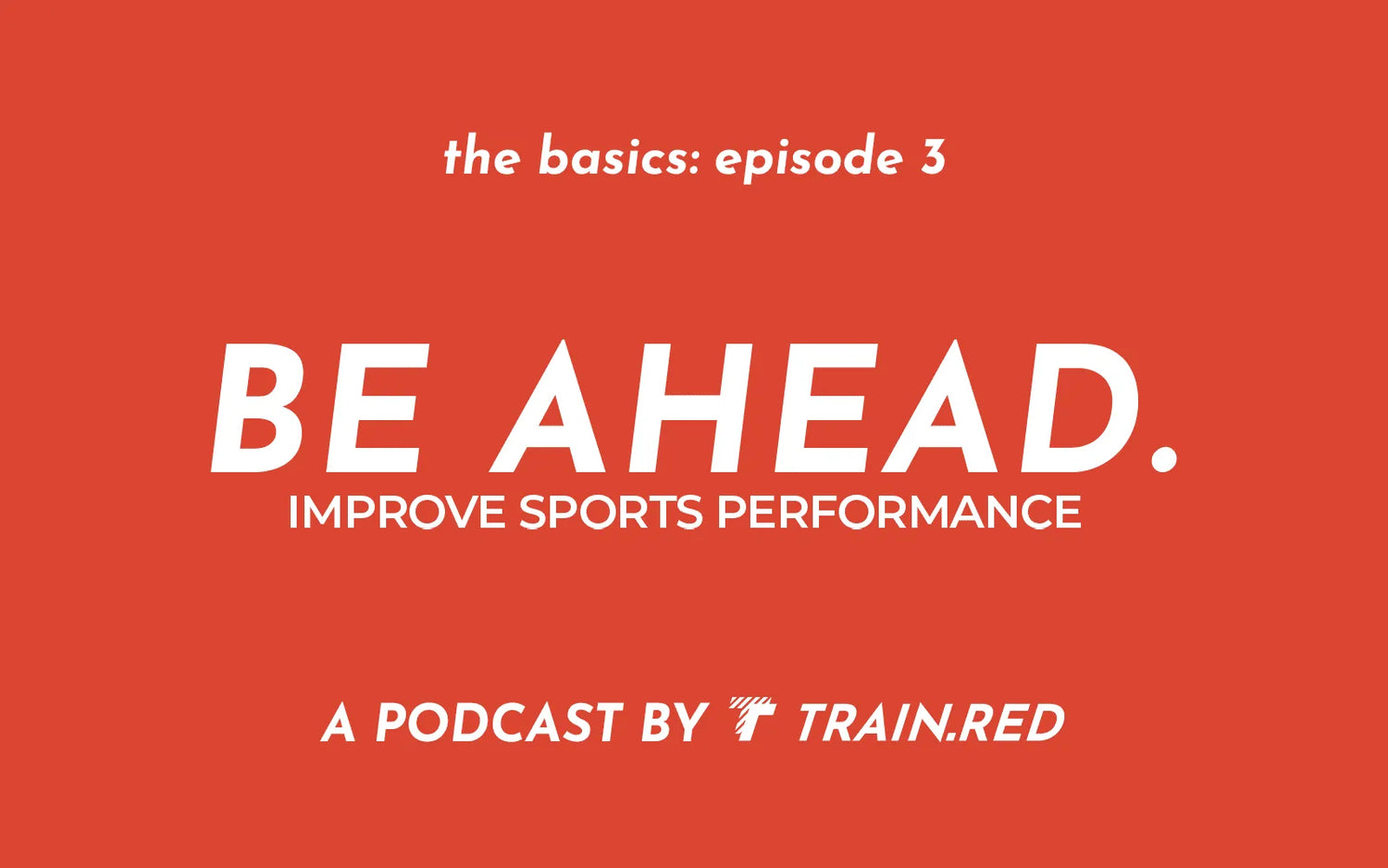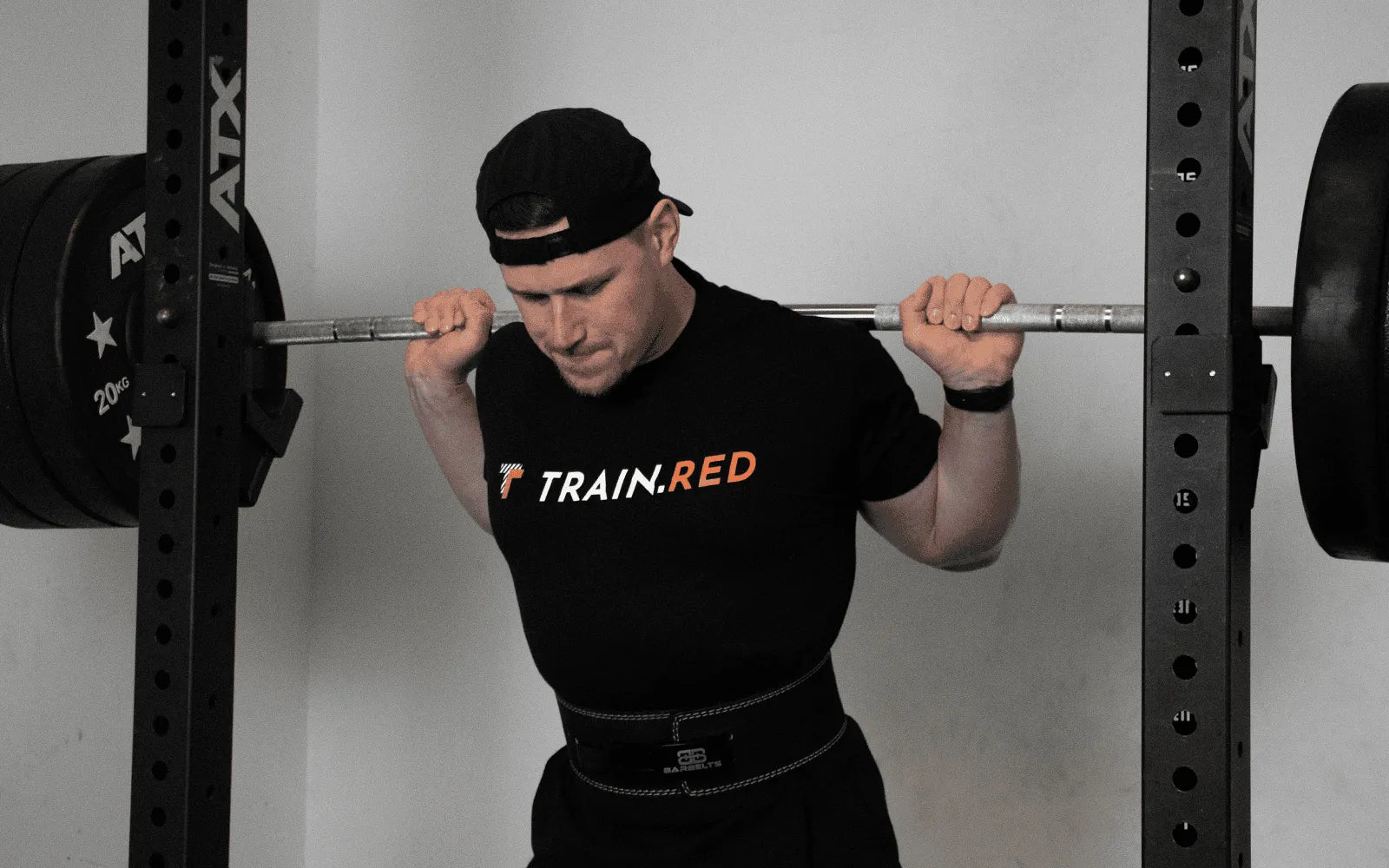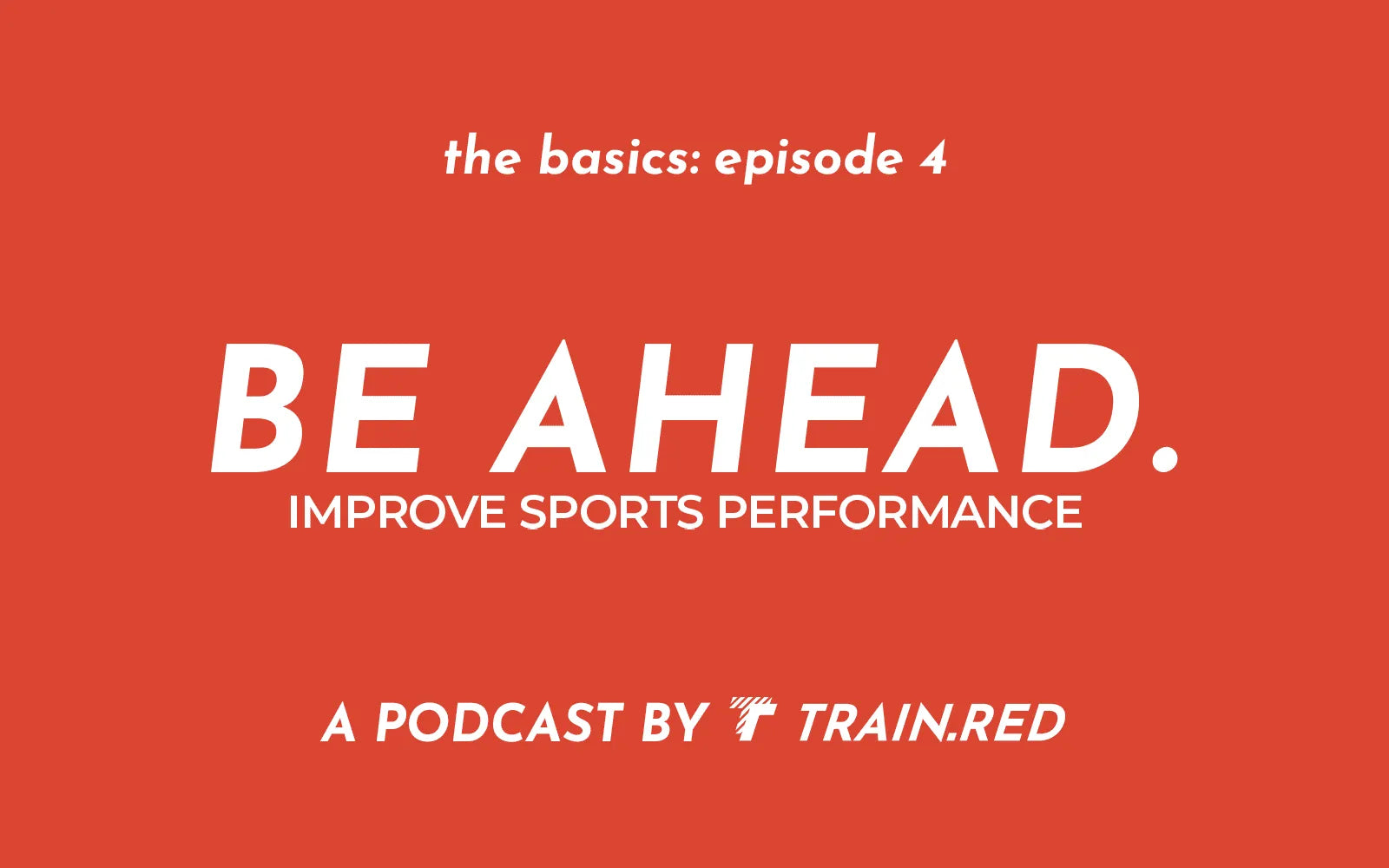In this episode, your hosts Kim and Jeroen will be discussing VO2Max, VO2Peak, what it is, how to measure, and also how to improve this number. Press play!
Transcript
Introduction: who are the hosts?
00:00 (Kim ter Stege)
Welcome back to BE AHEAD. podcast by Train.Red. My name is Kim ter Stege, I'm part of the Train.Red team and I'm the host of this podcast. I'm a sports enthusiast. I started my fitness journey after losing a lot of weight and I got very interested in fitness and health. I'm also a content creator. You can find me at @kimterstege across all platforms and I also have my very own podcast. I'm here with my co-host Jeroen.
00:24 (Jeroen Molinger)
Hi, my name is Jeroen Molinger. I’m the Lead Clinical Exercise Physiologist at Duke, at the Human Pharmacology and Physiology Lab, Research Program Director of the lab, and also Research Program Director of Duke Heart Transplantology at the Cathlab. My main focus in the research we do at Duke is all related to assessing muscle physiology and cardio-respiratory function.
What is VO2Max
00:45 (Kim ter Stege)
So Jeroen, last two episodes were about NIRS, and today we're going to talk about VO2Max simply because in the next episode we will get into what being fit actually means. So these two terms we're talking about a lot. So I thought it would be good to explain a little bit more about what VO2Max is, and how you measure it. So can you tell me a little bit more about VO2Max, what it is?
01:05 (Jeroen Molinger: (01:05)
Sure, sure. So VO2 stands for the amount of oxygen that you can consume in a period of time. That's kind of an abstract metric. So a little bit more from my, from a high, high perspective is when you do your exercise or you're doing specific tests like on the bike or on a treadmill, you're increasing your intensity. Then you'll see that your body demands more oxygen to move forward and your ability to utilize that oxygen, that is a way of how fit you are. And that specific fitness metric, we also call it cardiorespiratory function or cardiorespiratory, uh, fitness is the integration of those two systems. So the amount of blood that you can deliver when you are increasing your heart rate doing exercise and the amount of oxygen that the muscles can consume during the specific exercise. So there's always a, a number when we normally have, so a just a VO2 number, NOT a VO2Max, but just a VO2 number while we're doing our daily activities.
02:06 (Kim ter Stege)
Okay. So just to put it like in short for people to make it a little bit more understandable. So VO2 stands for, uh, volume of oxygen and the max is a maximum oxygen consumption within the body. Today we're mainly talking about the VO2Max and how to measure that. And I think you can actually, I would say almost feel it. If you're running on a treadmill and you're getting out of breath, obviously your body needs more oxygen. So is that the, the thing you're testing like that exhaustion that uh, well maybe not exhaustion, but more like you need more oxygen, you feel like you're getting out of breath.
02:14 (Jeroen Molinger)
Right. So going back to the cardiorespiratory part, So when you're getting out of breath, that is more the respiration part. So the lungs of demand or there is a trigger for a higher demand of, uh, of oxygen. So a way of compensating for that is just breathing harder, getting more air in so your frequency can go up so you don't avoid what you can go up. But also what you see is, uh, another way around that you will increase your heart rate because the heart rate will increase the amount of blood that's being circulated into your body. So you get more oxygen to the systems that needed. And of course when you're doing exercise that are mainly the, uh, the muscles.
What can you do when you know your VO2Max?
03:18 (Kim ter Stege)
Okay, it makes a lot of sense. So what can you actually, like if you know the VO2 number, how do you measure the VO2Max and what can you actually do with this?
03:28 (Jeroen Molinger)
Right. It's, it's an interesting, interesting question. The reason why it is such an interesting question is there is tons of science and evidence that there's a specific number the VO2Max as number that you drive during a specific exercise test as your maximum ability to utilize or consume oxygen in a given, given intensity has a very well prediction power for health and and disease. So what we see is that how fitter you are and the fitter defined as the more oxygen you can consume during a specific exercise test, the better you are in handling specific metabolic stress like disease, like surgery and all.
Health and VO2Max
04:07 (Kim ter Stege)
So you're basically saying if you can consume more oxygen, you, you are in better health, but how do we actually measure this? Is there a way of knowing this?
04:15 (Jeroen Molinger)
So how do we really measure that? And the reason why there's an interest from, from the Fitbits, the Apple watches, the Garmins and all, cause it's, it is a metric that defines the whole metric of being healthy. There's no other way of measuring it and, and or defining it. The way of measuring it are, can be the direct way and direct way really measuring it through an exercise test with a mask on and with the mask on we, um, sample air that goes in and out and the difference between the amount of air that you breathe in and out that defines how many oxygen you are consuming.
VO2Max and VO2Peak
04:49 (Kim ter Stege)
Yeah, that's definitely the way to get a very specific and very precise number. Um, but there's also ways to do it by yourself obviously. Can you tell me a little bit more about the VO2Max in this specific test?
05:03 (Jeroen Molinger)
Maybe good to, to go back in the terminology because there's a lot of terminologies regarding VO2Max or VO2Peak. Um, I will not go to the nitty gritty in, in in what's best, but I think you can, the real VO2Max is a max that you measure when there is a plateau and the plateau will see if you're going harder and harder, you cannot go up again. So no matter how hard you are, it kind of plateaus and the, the graph goes to more in horizontal way. The only way, the only that specific graph that you see are on, um, athletes or elite athletes that are pretty, pretty well fit. They only have those maxes. Anyone else who is less fit doesn't have that really well plateau. So the more the people I'm seeing currently in the, in the clinic, uh, have a VO2Peak. So they just stop because they have limitations, uh, which are not specifically the same limitations as a, um, uh, um, an athlete has. So there will be peaks, but in the, in the, in the sports space, we're mainly talking about max in the clinical space, we're more talking about peaks.
06:11 (Kim ter Stege)
So most people have a VO2Peak, which also means that you can improve that there's ways to improve and get that higher until you reach your VO2Max.
06:23 (Jeroen Molinger)
Yep, yep. No, definitely. And I think even, even there is currently, um, more evidence that we need to have, um, a little bit more comprehensive insight in that number because we're only looking at one number, what's just your peak? It doesn't show, uh, the real data in how you acquire the peak. So if you're looking at specific, um, sports where I think the max failure in itself isn't really important to know. Um, an example for, for what we're doing here in the US instance with basketball is, if you are an elite basketball athlete, um, and you do a treadmill test, uh, and you're acquiring your VO2Peak, that's fine to know. And I'm sure there is some merit in doing it that you have an insight in how really fit you are, but it doesn't give you any, any information in how good you are on the, on the court because during the court you will never reach your max. An endurance athlete or a sprint athlete will do that. But if you are more in the soccer, in the hockey and all that stuff that is not, is not a max out, uh, defined, um, sports. So they need, still need to have I think the VO2 there, but more like how efficient are you? So if you can run, if you can run or uh, how much watts can you put on the bike or whatever you can do, how efficient are you when you're using your oxygen. So the less oxygen you consume with the high amount of speed or power you have, the more efficient you are and eventually will show you that you are able to do, uh, um, can, can do faster and longer because you are far more efficient in moving forward.
Can you measure this yourself?
08:06 (Kim ter Stege)
Okay, makes a lot of sense. Um, so a quick question. How do you even, like, can 'normal' people that don't go to, uh, a lab or something, can they actually measure this? And then also how important is it to know this measurement?
08:24 (Jeroen Molinger)
Uh, good question. Yeah. The only thing right now in really measuring it directly is, uh, through the use of a metabolic card, such an analyzer when you have a mask on a measurement through the mask. Uh, right now there's only been done in specific labs. Uh, there is still some technology coming up, um, like to, VO2Master, which we use. I think we we'll go into it a little bit later on in some other episodes is that's, that's wireless, that's mobile, that's far more cheaper what you can do. I think even coaches and PT's, uh, uh, were able to, uh, to use this, this, this technology instead of, uh, the labs that are um, yeah, have far more expensive cards and, and are far more complex to, uh, to deal with. Going back to your question, do you need this number? Um, um, yes and no, No, it's, it's, it's still an interesting number to uh, uh, uh, to know in, in regard to how efficient are you in regard to your training? Are you, is your training goals, are they matching with your numbers or can you tailor your training a little bit better based on your zones? Not only your zones on your heart, but also your zones on your VO2 numbers. Because if you can, can um, can compare, uh, there is still another kind of an indirect way of assessing it, uh, like the Apple Watch does and I think the Garmin does also, Fitbit has a way of assessing indirectly your VO2Max number. Um, and that's mainly based on, on an algorithm that defines the, um, uh, the combination of activity forces, your, um, your heart rate and heart rate recovery.
09:57 (Kim ter Stege)
Uh, a Fitbit or Apple Watch is way more inaccurate than let's say the VO2master or going to a lab.
10:05 (Jeroen Molinger)
Absolutely. It, it'll more, I think it, it will, um, the only way using it that way is just looking at a change, at a slope change. If there was any trending, moving upwards downwards don't really, I think the specific number doesn't really make sense. So you cannot really, really, really combine a number derived from an Apple watch and the same number from a exercise testing. You can see that would be the same. It'll be more or less that you can, there is an estimate in, in following up how, um, how your VO2 is changing over time.
Can you improve this number?
10:39 (Kim ter Stege)
Yeah, exactly. Okay. So for most people it's not really important to know this number. I mean, it's fun to know, but they shouldn't get out of their way to, to measure this number. And then also in the next episode we will talk about what defines being fit and we will also talk about a calculation so you can actually know the number if you do different ways, right.
11:00 (Jeroen Molinger)
And it is still, I think, a very interesting number to, to have, uh, in, in regard to your physiology on the episode we will talk about potentially, um, uh, when you're a fit and you are, uh, you need to acquire a, a COVID infection, maybe then this number can be of interest because you really need to have a better understanding and the reason why you are so fatigued, um, or, or have any viral infection where you have to have a better understanding in how can I go back to my normal, uh, normal level again. And the, the, the thing about VO2 is kind of weird is that, um, it's the only metric I know from our physiology that is able to maybe fivefold in increase. So if you are an elite athlete, your VO2 number, your relative VO2 number, will be around 60 plus or so. And everything between, um, yeah, call it 40 and 60 is, is is, uh, you're doing well, um, below 40 and uh, and and 20, so 25, that's the kind of the lowest group. Uh, what we see in our, in adjusting the healthy, healthy people and population in our clinic and people who had um, um, have heart issues or lung issues, they can even go to below 10. So you have people who have ten first below 60. Yeah. So you see that there is a huge amount of variation and a huge amount of, um, of the ability of the system also to compensate for. And the, the maybe cool thing for people to know is there is a lot of discussion going around if VO2 is uh, uh, can you change it by training or is it more a genetic, um, thing that you have, uh, so you're born with a high VO2 number, you can increase a little bit, but that that's just it. Or you're born with a low VO2 number and you can do anything you want, but you'll be staying low. Uh, and we are currently seeing as that is not the case. I think for still the, the highest of the live athletes, yes they have of course a very well defined DNA profile, but still you can increase.
13:01 (Kim ter Stege)
Yeah, that's, but that's with everything, right? So if you're in the higher level of the number, it's very hard to increase more because you have to be like extremely on your training, on your sleep, like everything around you to maybe improve that. But if you're on the lower part of the numbers, you can easily increase it a lot.
13:19 (Jeroen Molinger)
Yep, exactly. Exactly. Very much so. And, and the easy part is you can increase it, uh, uh, at a very, within, even with a specific training, we see you can increase your numbers within three or four weeks time. Yeah.
VO2Max in short
13:32 (Kim ter Stege)
Okay. So everything is very clear to me Jeroen, but can you give like in maybe three sentences short what it is, why it's important and Yeah.
13:43 (Jeroen Molinger)
Sure. So VO2 is a number that, that is a metric that defines your ability to utilize, uh, and use oxygen during exercise number that gives insight in your whole physiology and health, it is a number that we use define how fit you are. It's a combination of looking at lungs, heart, and integration with the muscle.
14:04 (Kim ter Stege)
And then also to finish it off. That number is, uh, very easy to increase if you're on the lower end.
14:12 (Jeroen Molinger)
Yeah, you can, you can increase the number for sure. Uh, um, and, and the more unconditioned or untrained you are, uh, the ability of the system to uh, uh, to super compensate on the level of the heart and the level of ventilation and the level of the, uh, of the muscle, uh, is very significant. So you can see difference already, significant difference already, uh, with, uh, specific training in, in a period of three or four weeks.
Outro
14:37 (Kim ter Stege)
Okay. Well I think that's it for today, Jeroen. Um, in the next episode we are gonna talk about the combination of NIRS and then also the VO2 number and how you can actually measure how fit you are in combination with the, uh, oxygen. So again, thank you so much for being in this episode and I look forward to speaking to you in the next one.
Thank you for listening to today's episode. You can find us across all social media @Train.Red. We hope to see you here next time and don't forget to follow this podcast so you don't miss out any of the next episodes. If you're interested in muscle oxygen sensors, the Train.Red FYER, go to our website Train.Red. The link is also in a description.



